
On the land and in the towns they’re affected to varying degrees;
some find it harder to cope. But they all agree something has changed
- Read part one of The New Normal here
If
you don’t fully appreciate the complexity of rural communities, farmer
Peter Schmidt is not the sort of bloke you would be expecting in the
Mulga Lands. His place is 21,000 hectares – 52,000 acres in the old
money – and his family have been there since his grandfather selected
blocks in the 1890s. The closest town is Wyandra, a blip on the highway
on the way to Cunnamulla from Charleville – a drive that reveals the
disused fences of smaller blocks long abandoned as unsustainable.
Schmidt though is still at his homestead at Alawoona, its sheds and outbuildings surrounded by a metre-high levee, standing like a bad joke in their sixth year of drought. He put it in after the 2012 flood, which washed a foot of water through his house. Problem is, that flood heralded the start of the dry and it pretty much hasn’t rained since. He jokes with station hand Joe that he cursed the place and might have to break the levee to bring on the rain. But far from being a man of superstition, Schmidt is a rural scientist, with two masters degrees – one each in rural education and cattle behaviour. He has a softly spoken manner and a sense of humour born in the Mulga.
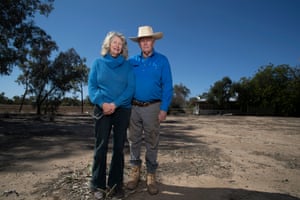
Schmidt though is still at his homestead at Alawoona, its sheds and outbuildings surrounded by a metre-high levee, standing like a bad joke in their sixth year of drought. He put it in after the 2012 flood, which washed a foot of water through his house. Problem is, that flood heralded the start of the dry and it pretty much hasn’t rained since. He jokes with station hand Joe that he cursed the place and might have to break the levee to bring on the rain. But far from being a man of superstition, Schmidt is a rural scientist, with two masters degrees – one each in rural education and cattle behaviour. He has a softly spoken manner and a sense of humour born in the Mulga.

“Well, it’s unreliably reliable,” says his partner, Kathryn.
‘Dry eight years in a row’
Schmidt first started thinking about climate change after seeing a program on the astronaut Neil Armstrong who, before he went to space, thought the earth’s atmosphere was like the peel of an orange. In the pictures of space, Schmidt could see that the thickness of the atmosphere was more like an onion skin, and it stayed with him.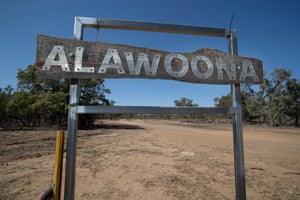
It is the middle of winter when we drop in, and though the fine day stretches over the place like a shroud, there is a chilly wind that blows through the mulga. Schmidt welcomes us into a small closed kitchen as he loads some old gidgee (Acacia cambagei or stinking wattle) into the wood stove and offers us a coffee.
Schmidt has lived through many droughts but it’s the big ones he remembers – 1958, 1965, 1983. While southern Australia suffered through the Millennium drought during the noughties, up in the Mulga Lands, Schmidt says it was “dry for eight years in a row”.
“The essential thing was there were two or three periods there where the temperature was above 40C for 15 days in a row and it just sapped all the moisture out of the soil,” Schmidt says. “That’s the difference between this drought and the others.”
He had 100mm on the backblocks of his place last November, 59mm in March and very little since then.
It doesn’t stop with one rainfall
Drought has long been a part of the Australian climate and features in Indigenous stories and history. Indigenous agricultural and land management practices, documented by historians such as Bruce Pascoe and Bill Gammage, consider drought as a subjective notion – that is, it’s a state of mind. This is replicated among today’s landholders, reflected back in comments like these: “the only thing we know about drought is that it will end”. That is, it is a period that needs to be managed, like any other. We will explore more of this thinking about drought in the last of this series.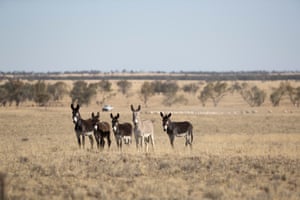
Then there is the scientific definition of drought. According to the Bureau of Meterology, drought is serious or severe rainfall deficiency – essentially a period of prolonged dryness.
By this measure, south-west Queensland has experienced almost seven years of dry times. Yet when Guardian Australia visited the region, locals were keen to reject some commonly held assumptions. Drought is not uniform. Parts of Queensland have been in drought for seven years but it does not mean those communities have not had any rain. Drought doesn’t stop with one rainfall. Even in NSW, which is 100% drought-declared, some areas are not strictly in drought. Each region responds differently to drought and has different assets and challenges. All of the community is affected by drought, not just farmers. Businesses, shops and social events can close down as people hunker down and stop spending. Not every farmer is male – businesses are mostly partnerships – and not every farmer is on her last legs.

“It’s so much easier to be a good manager in a wet year,” Augathella farmer Rachelle Cameron says. “There is grass everywhere and no stress.”
Summers ‘so scorchingly hot’
Four hours north of Wyandra, Louise and Andrew (Marto) Martin are sheep growers on the Mitchell Grass plains near Tambo, 860kms north-west of Brisbane. Looking out over the high grass, it doesn’t look too bad, certainly not the desert landscape pictures that metropolitan audiences are used to in drought. Macfarlane station is on an ancient inland sea – the Martin’s fossil collection contains ammonites and Huon pine, spat out of the black soil plains that expand and contract depending on the water content.Both Martins work the farm, while Andrew is also mayor of the Blackall-Tambo region. This year they got a bit of autumn rain and made 200 bales of hay. They reduced their stocking rate to match the season, as much as is possible with lambing ewes. They’re not in favour of what Marto calls “agrarian socialism”, believing that subsidies create dependency.
“The best way of dealing with drought is accepting you are going to have one,” Andrew says.
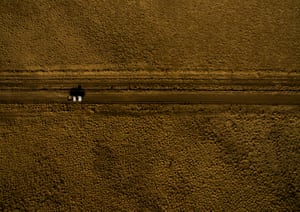
“It’s quite unusual to get over 40C here but this last summer and the last couple of summers have been so scorchingly hot,” she says. “You can see the water being sucked out of the dams, sucked out of the soil, sucked out of my life and you can’t plan for that.
“The way to plan for drought is you just have to make a decision and if you haven’t got enough grass, you sell [stock].”
‘Policy adverse to diversification’
Karen and Bill McLennan and their son Michael are in the Mulga Lands on the highway to Roma, just outside Charleville. Their diversification plan was an olive plantation – Sommariva Olives – made into oil, soap, tapenades and other products. They are trying to stay agile, in the government’s words, to drought-proof. Bill and Karen also work in the panel-beating business in Charleville through the week; they spread themselves thin in an effort to survive the climate and the conditions.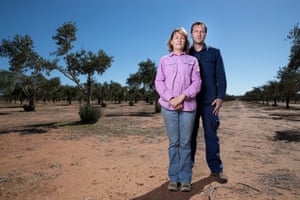
Karen describes the good times, when the grass is above their knees, but looking out from their back deck off the olive shed, it is all mulga and red dirt. The olives get enough water to yield a crop every second year. She describes a life that is filled with work, in the panel shop, in the olive shed, in the mulga. The olives were to be the retirement plan, but their oil won awards and it has increased the cashflow in dry times.
They find government policies frustrating, the rhetoric encouraging farmers to diversify while erecting hurdles, or as Michael says, “government policy is actually adverse to diversification, it’s crazy”.

Pressure has increased on the family after the bank revalued their properties and stock as a result of the downturn in conditions, which changes the interest payments.
Like all the farmers we speak to, they appreciate the city’s donations, though they have not received anything. Hay is tricky, given once you start feeding cattle, you have to keep going. One or two bales will not last long.
One of the big movements in farming practice over recent years is towards grazing practices that respond to climate rather than keeping a set number of stock no matter what the climate. There are a number of farmers now who sell down stock and close down for dry periods but this requires a certain equity level. For the McLennans, it is not an option.
"It’s easy to say you need to destock going into a drought – but you can’t"
“It’s easy to say you need to destock going into a drought, but you can’t,” Michael says. “The cost of getting into one of these places, you have to keep producing because if you don’t, how do you meet your loans? What is your income? In drought, costs go up, but cattle prices go down because no one else can buy for the next year.”
North west of the McLennans, Doug and Rachelle Cameron live on the old station of Nive Downs, originally over 738 square miles with its own post office and general store. It was split up in the 1960s and the couple have been on 34,000 acres north of Augathella since 2004.
“The new norm seems to be drier and hotter over the years we have been here, with our average summer temperatures,” Rachelle says. “I wouldn’t say [climate change] is not happening. It seems to be all or nothing in the country.”
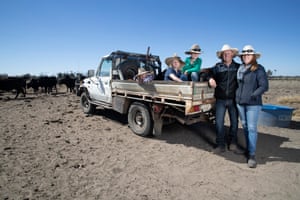
The Camerons are trying to increase cash flow by diversifying into production of their Nive Beef jerky. Doug hit on it after a cattle price crash due to the 2011 temporary live export ban. At a roadhouse on the way back from the saleyards, he saw a 25g packet of beef jerky for $5 after he just sold cattle for $50 a head.
Doug was sick of being a price taker. “It didn’t matter what I did to the cattle – we could have the best genetics, the best everything – but outside influences just crushed us. I thought maybe we can make something out of the jerky and set the price.”
Around Augathella, they grow their haystack in summer and cattle eat it down in winter. By autumn, they know whether they will have enough feed to get through the winter, and for the past five years it has never been enough, so they have sold off cattle.
“This year is worse than every other year. We are missing all that growth, lately it’s been late rain, with a [short] eight-week window to grow before it cools out. You are not getting bulk feed through and that’s what hurt us in the community.”
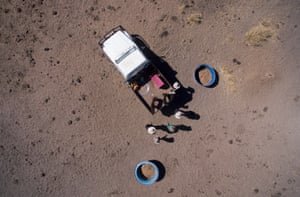
There was no redundancy package because the employer was not large enough. Dave was reeling from the job loss but Margie got active. The couple, in their late 50s, were carrying a bit of debt from the last drought when they were left unpaid for contracting work. So while looking for a new home, Margie also contacted their bank to apply for hardship provisions which the bank duly provided. But when a good friend gave them some money to tide them over, the bank dropped the hardship provision.
Margie applied to Centrelink for Newstart, but given the couple have had various micro businesses, the application process was arduous to prove they had no hidden assets. She also contacted high profile drought charities who told her because they were not farmers, they could not help. Sixteen weeks after losing their job and home, they were still waiting for Newstart.
The only assistance they have received is from the Country Womens Association, which pays up to $3000 for household expenses such as fuel, power, insurance and the like. Another city based charity arrived with groceries, lining up donated goods like a supermarket at a local hall.
“The government needs to look after people who become unemployed with the drought,” Margie said. “There is no focus on contractors, the small businesses, it’s hard to get Centrelink assistance and those people end up leaving town.”
The dry weather also places pressure on regular social events such as picnic races, campdrafts and other gatherings, which are important economically and socially. At a time when people need to keep an eye on others, the usual events can disappear from a town calendar, having a material effect on the state of mind of its inhabitants.
‘Women get depressed as much as the next man’
Christine McDougall is the director for mental health, alcohol and other drugs for the South West Hospital and Health Service under the Queensland government. Based in Roma, her patch is one of the largest health services in the state, covering 320,000 square kilometres, but there are only 29,000 people scattered across that vast “corner country”. McDougall has been a mental health nurse since 1974 but she says it makes her cry to drive around Charleville and Cunnamulla and see the effect on the community, first of the floods of 2012, which wrecked the soil and land, and now the latest drought.There are no mental health beds in the south west, and people are transported by the Royal Flying Doctors Service if necessary. The service aims to keep people in their own community, using local hospitals and providing full support as much as possible, via telehealth consultations and regular visits by clinicians.

“We try to keep as many people as we can out here because it’s traumatic going into hospital in an aeroplane,” says McDougall. “We can’t make it rain but we can keep them going until it rains – we hope – and if they get the money from the government and all these donations coming, we can keep the social and emotional stuff going.”
A straight-talking dairy farmer’s daughter from Gippsland in Victoria, she presses the point that women are farmers too.
“People think of farmers and they have an image of a man; you ask women what they do and they say we are farmers. They know everything that is happening on the place. They are as likely to get as depressed, miserable or suicidal as the next man.”
Three years ago the state government created positions for Regional Adversity Integrated Care Clinicians (Raiccs) to cope with drought and disaster. The approach was to get to as many people as possible, no matter how remote and no matter how few people turn up. The number of suicides has dropped in the region from 13 to 4 over the past two years.
“I have not forgotten anyone I have looked after who has taken their life by suicide, you never forget them, and you always think what if I had done this or that – you don’t know,” she says.
“We have to acknowledge too we never know the ones we stop. It’s no small thing to go from 13 to 4, given the way it ripples through the community.”
If you need support call Lifeline on 131114
*names have been changed
- The New Normal is part of Our wide brown land series, made possible thanks to support from our readers
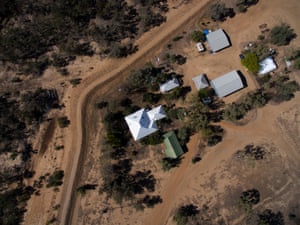
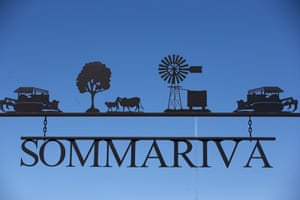
No comments:
Post a Comment